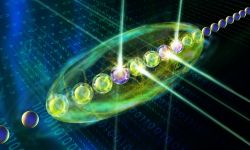
In a recent paper in Physical Review Letters, scientists around Andreas Elben und Benoît Vermersch from Peter Zoller's group present a new method with which quantum states prepared on different quantum computers or quantum simulators can be compared.
Throughout the world, quantum computers are currently being developed. Research institutions and companies use various physical systems for their realization. For example, Innsbruck is working intensively on quantum computers with captured ions systems, while others use superconducting quantum bits or Rydberg atoms, for example. Since quantum computers are superior to classical computers in some respects, engineers are faced with the challenge of how to check the accuracy of quantum computers when their complexity exceeds that of classical supercomputers. One possibility is to perform and compare the calculations on several quantum machines. If they reach the same result, it can be assumed that the result is correct.
Comparison via random measurements
The Innsbruck researchers are now proposing a new method for verifying the result by comparing two quantum computers in pairs. They should solve the same problem, i.e. ideally prepare the same quantum state. "Our method now enables us to compare these quantum states directly," say Andreas Elben and Benoît Vermersch, the first authors of the publication in Physical Review Letter. They designed and investigated the new technique in close collaboration with Christian Kokail and Rick van Bijnen in Peter Zoller's working group. "The idea is to prepare the required state on both devices, perform the same random measurements on both quantum computers and then use the statistical correlations of these random measurements to obtain the fidelity, a highly sensitive measure of comparison, of the two quantum states. The method is a generalization of techniques presented by the Innsbruck physicists in spring in the journal Science together with experimental physicists led by Rainer Blatt and Christian Roos.
Method offers many advantages
A novel feature of the method is that the comparison is made using classical communication. Therefore, the quantum states in the two quantum devices can be realized at different times and places. "Thus, quantum calculations can also be compared between Austria and China or the USA," says Andreas Elben. Furthermore, the method is very efficient and allows the observation of dozens of quantum bits with a realistic measuring effort, and is also applicable to mixed states, such as always occur in the laboratory.